The Good Ol’ Country Store
by Donald-Brian Johnson
Kitchenalia. It comes in many forms, and collectors often focus on just one category.
Salt-and-peppers, for instance. Or whistle mugs. Perhaps pie birds, egg timers, or vintage advertising catch your fancy. There are even folks who collect original food packaging (pristine condition preferred, food long-removed). But those looking to add an extra layer of authenticity to their kitchen collecting often specialize in artifacts from actual “general” or “country” stores – a staple in any town of any size from the mid-1800s well into the 1950s. Such objects contribute to a kitchen’s homey atmosphere and remain readily available and affordable (most average well under $100). A carefully selected assortment of country store-themed décor items can create a cozy, authentic shrine to the joys of days gone by, even in a modern kitchen where the most frequently used appliance is the can opener.
A wonderful place was the crossroads store,
As it stood in the days of old,
Where we traded our butter and new-laid eggs,
For the merchandise they sold.
If you’ve never dealt at the crossroads store,
You’ve missed a lot, I see,
And the folks who have, will bear me out,
I think we’ll all agree!
– The Crossroads Store, Harry Brokaw, Hometown Ideals, June 1960
A pioneer predecessor of the “crossroads store” was the “trading post,” which provided early settlers with a bit of everything, (everything useful, that is), from foodstuffs to farm implements, in exchange for items offered in trade. By the mid-1800s, the retail version of this concept—a multitude of must-have products, available in exchange for cold hard cash (or credit, until harvest time)—was the norm, at the country or general store.
For many years, it was the storekeeper who filled your order, often knowing in advance just what you needed. Baking powder? Buggy whips? Shotguns? Sarsaparilla? The general store had it all, and the general storekeepers (remember the Oleson’s Mercantile on Little House on the Prairie?), knew exactly where it all was. (That personal touch lasted until 1916 when Clarence Saunders opened his first Piggly Wiggly and introduced the self-serve concept.)
The general store was the hub of the community, filling not only shopping needs but social needs as well. Store hours were flexible, designed to suit busy schedules. Farm wives looked forward to socializing with friends, on their weekly evenings in town. Storekeepers became integral parts of the community, often solidifying their indispensability by taking on additional tasks, such as undertaker or postmaster, and making their facilities available for any and all community-minded endeavors.
One such all-purpose gathering spot was The Shimer Store in Chatfield, Minnesota. Ruth Shimer, daughter of the proprietor, worked at the store at the turn of the twentieth century. A very young yours truly had the privilege of interviewing a very elderly Miss Shimer for a Memory Project compiled in 1976 as part of America’s Bicentennial Year observance. Blessed with a laser-sharp memory, and a wicked sense of humor, Miss Shimer offered up colorful tales of daily life in a small-town country store:
“My father, Frank Woodbridge Shimer, was born in McGregor, Iowa in 1853. When he was ‘six months old,’ he became dissatisfied and persuaded his parents to bring him to Chatfield, Minnesota.
“Mr. C.M. Lovell came from the east before 1870 and opened a general store in Chatfield. As a young boy, my father went to work for Mr. Lovell. When Mr. Lovell married and brought his bride home, my father thought they should celebrate. So, he opened a can of peaches! Eventually, my father became the owner of the Lovell Store.
“Groceries were kept in the back, with dry goods in the front. A large coffee mill ground by hand many pounds of coffee. Sugar came in 100-pound bags and was dumped into a big barrel, to be sacked up as wanted. Eggs were brought in 30-dozen cases, every egg having to be candled (looking at the inside of a developing egg by holding it over a flame in a darkened room) before being shipped to Chicago. A big register from a one-lung furnace heated the store, and it was around this that many yarns were told by some regular natives.
“Traveling men (‘drummers’) brought samples in trunks by train. These were drayed (pulled in a strong cart or wagon without sides) to the Medary House (the local hostelry) where two sample rooms were used to display the wares.
“One time, a salesman joined the group around the heater and told about his meeting up with an American Indian. He grew very dramatic, and with much gusto and waving of arms, told how the fellow took a big knife and cut his scalp right off! Grabbing his toupee, and waving it wildly in the air, he demonstrated. That became the yarn for the day.
“Another salesman once came to call on Mr. Lovell, who was out. My father told the drummer that Mr. Lovell was very deaf. When Mr. Lovell returned, father whispered to him that a very deaf salesman was waiting to see him. When the two met, the hollering was terrific, and my chuckling father rushed out the back door before they caught on.
“Ready-to-wear clothes hadn’t hit the market then, so bolts of yard goods and other commodities came from Marshall Fields in Chicago. High-button shoes, overshoes, overalls, and a case of pretty handkerchiefs and ribbons were always on display.
“Meetings of all kinds were held in my father’s office. The city council, church, lodge, cemetery association, and other gatherings of public interest were held there. My father grew up with the community, and knew everyone for miles around. He had many good friends, and learned there were no better people on earth than those right in his own hometown”
To think I once saw grocery shops with but a casual eye,
And fingered figs and apricots, as one who came to buy.
For in those bygone days I saw no sails above the tea –
Grocery shops were grocery shops, not hemispheres to me.
– Counters, Elizabeth Coatsworth, Compass Rose¸ 1929
By the early 1900s, the concept of the general store became more standardized, yet retained many familiar elements. From 1935-1951, Campbell’s Department Store was a hive of community activity in the small town of Bridgewater, Iowa, just sixty miles or so from Des Moines. The proprietor’s daughter, Sally Hanson, had these fond memories of life at a country store, mid-twentieth century style:
“My dad ran the store. There were also a butcher and a checkout person, and my brother helped out, too. My dad would drive to Des Moines to purchase the groceries; the only car we had was a panel truck. When they first started out, before they had a house, mom and dad set up housekeeping in the store balcony. Our store had beautiful all-wood floors, but keeping them swept and clean was quite a job. We always had to sprinkle a ‘sweeping compound’ first, before getting out the broom.
“Campbell’s Department Store had three ‘departments:’ groceries, meat, and dry goods. We were open daily, plus Wednesday and Saturday evenings. On Saturday nights, the women would come in to shop. Groceries were sacked, and dry goods wrapped in brown paper and tied with string. The groceries would be put into a cardboard box, and set in the front window area. Then, the women would go out and find a friend to sit in a car and chat with, while their husbands visited the pool hall. The store couldn’t close until they picked up their groceries. Sometimes, it was close to midnight!
“On Saturday nights, my mother would take the ‘overripe’ produce home from the store, and on Sunday mornings we would have sliced bananas in orange juice for breakfast.
“At the back of the store were cold storage lockers. People would process their meat and bring it to their locker. The keys were kept hanging right outside the lockers—a real honor system!
“In the basement was the vinegar barrel. People would bring in their empty glass gallon jugs to be filled with vinegar. Cookies came in square boxes. The lid was taken off, and replaced with a glass door, so customers could sack their own. There was a Coke machine too – a red one. You just opened the lid and reached down into that cold water to get your pop. The opener was on the side.
“Usually twice a year, we’d drive to Omaha, (about 80 miles away), to get dry goods and clothing to sell. Campbell’s carried everything from handkerchiefs and aprons to hosiery, shirts, blouses, and underwear. There were even wool samples to look through, for those wanting to order pants and suits. Lots of ribbon too, measured by the yard. My sister loved selling that ribbon, measuring it out.
“Near the furnace were the shoe shelves; twice a year, the salesman from Brown’s Shoes in St. Louis would come to get the shoe orders. Behind that were shelves of jeans, overalls, and work clothes. When my sister and I were young, we would crawl in there and take a nap.
“My Mother would hem up the men’s pants when needed. Once, I remember we were delayed going to a 4th of July parade in another town because she had to do a last-minute hem.
“Each December, a group would get together and fill small paper bags with an orange, peanuts in the shell, and that hard Christmas candy. When Santa came to town on the fire truck, he would hand out the sacks.
“Today, Campbell’s building in Bridgewater is still a grocery store. After we left, somebody else operated it for fifty-plus years. Now, a young couple owns it. I wish them much luck, and as many happy memories as I have.”
The store is gone, but I recall the time
When I could buy all heaven for a dime.
– Country Store, Helen Virden, 1998
Happy memories. That’s the calling card of the country store, its memorabilia still brightening kitchens of the present with the heart-tugging nostalgia of the past. Maybe it’s the appeal of colorful labels and unusual containers. Or the jolt of recognizing a once-upon-a-time household necessity, now long forgotten. Regardless of the reason, country store collecting is an appetizing avocation, even for the culinary-skill-deprived among us (and we know who we are). Bon appétit!
Donald-Brian Johnson is the co-author of numerous Schiffer books on design and collectibles, including Postwar Pop, a collection of his columns. Please address inquiries (or cooking tips) to: donaldbrian@msn.com Photo Associate: Hank Kuhlmann, Photos by Donald-Brian Johnson, Campbell store items courtesy of Sally Hanson.

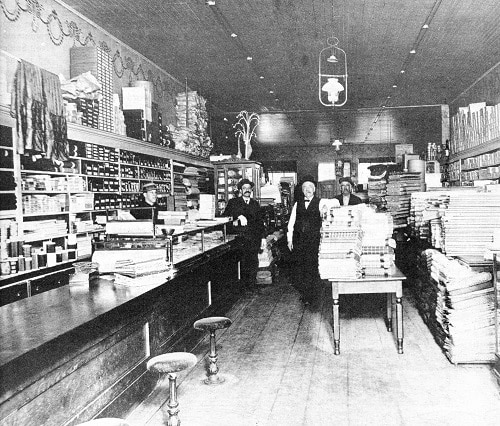
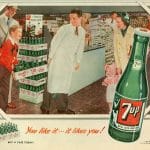

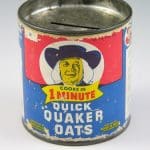
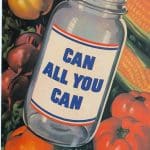
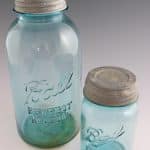
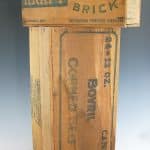


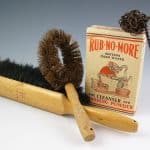
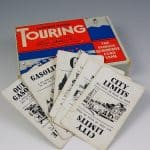
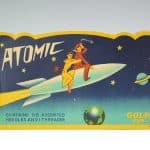
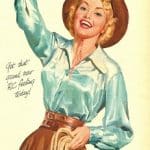
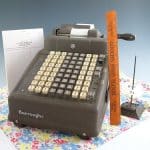
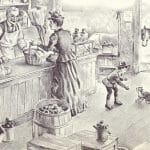




Related posts: